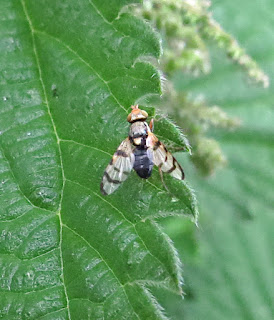Highlights
4 Little Egret with 2 on the scrape, where there were also 3 Oystercatchers, a Redshank and a Green Sandpiper feeding along the waters edge. Over head there were 4 Lapwing, and feeding over Pit 74 there were 13 Common Tern with a few squabbling on the rafts. There were distant calls and songs from a Cuckoo and Nightingale.
In the hedgerows and nettles were hundreds of male Common Blue Damselflies, with just 5 females seen. In amongst them were 3 Blue-tailed Damselflies and I also came across some interesting flies and hoverflies with: Picture Fly, Herina longistylata, Pellucid Fly, Volucella pellucens and Hoverfly, Anasimyia contracta.
Here are a few images from this morning.
One of at least 13 Common Tern over the Pit this morning.
A Common Blue Damselfly. There were hundreds of males just resting on the nettles and every time a female flew by..........
.........they took off in pursuit, in the hope of mating with one, as this male did.
Another male Common Blue Damselfly and a Nettle Aphid just in front of him. I had no idea until today, that there are at least 34 Aphid Species in this country. At least this one was fairly easy to ID on a nettle!
I suspect this is a Blue-tailed Damselfly.....
....and another. It could be confused with a Scarce Damselfly.
Picture Fly, Herina longistylata
And what a difficult fly to ID. There are several similar looking Picture Flies, but I'm 98% sure this is Herina longistylata. But then !!
Pellucid Fly - Volucella pellucens (Sometimes called the Pellucid Hoverfly, this is one of the largest flies in Britain).
Harlequin ladybirds are a highly successful invasive species and there numbers have rocketed over the past few years. They are pretty hardy ladybirds and have no problem outcompeting our native species such as the 2-spot ladybird for their aphid prey. It doesn't help that the larvae of Harlequins, also eat the larvae of our smaller native ladybirds.
And here is a 2-spot Ladybird, hopefully it can compete against the Harlequin
The Hoverfly, Anasimyia contracta. I saw it quickly in the corner of my eye and just managed a record shot. More Here on this Hoverfly
Birds Recorded
Great Crested Grebe, 11 Cormorant, 4 Little Egret, 1 Grey Heron, Mallard, Tufted Duck, Moorhen, Coot, 3 Oystercatcher, 4 Lapwing, 1 Redshank, 1 Green Sandpiper, Black-headed Gull, Herring Gull, 13 Common Tern, 1 Stock Dove, Wood Pigeon, 1 Cuckoo, 2 Swift, 1 Great Spotted Woodpecker, 2 Sand Martin, Dunnock, 1 Nightingale, Robin, Blackbird, Song Thrush, Reed Warbler, 1 Cetti's Warbler, 1 Garden Warbler, 3 Common Whitethroat, 2 Blackcap, 1 Willow Warbler, Great Tit, Blue Tit, Wren, Magpie, Carrion Crow, Jackdaw, 2 juvenile Starling, Chaffinch, Goldfinch, Greenfinch and Reed Bunting.
Also
Also
Blue-tailed Damselfly, Ischnura elegans
Common Blue Damselfly, Enallagma cyathigerum
Nettle Aphid, Microlophium carnosum
Picture Fly, Herina longistylata
Pellucid Fly, Volucella pellucens
The Hoverfly, Anasimyia contracta
2-spot Ladybird, Adalia bipunctata
Harlequin Ladybird, Harmonia axyridis











